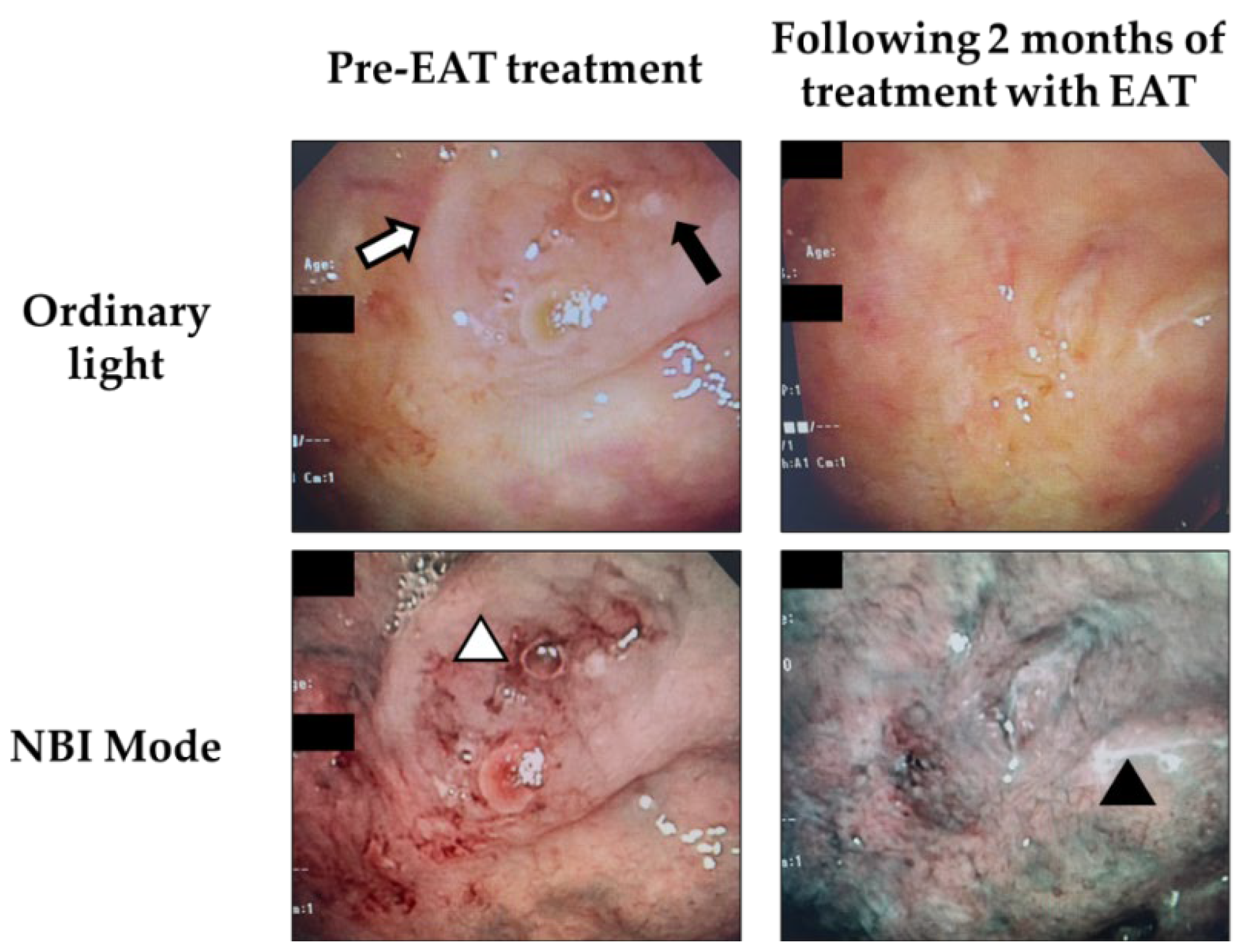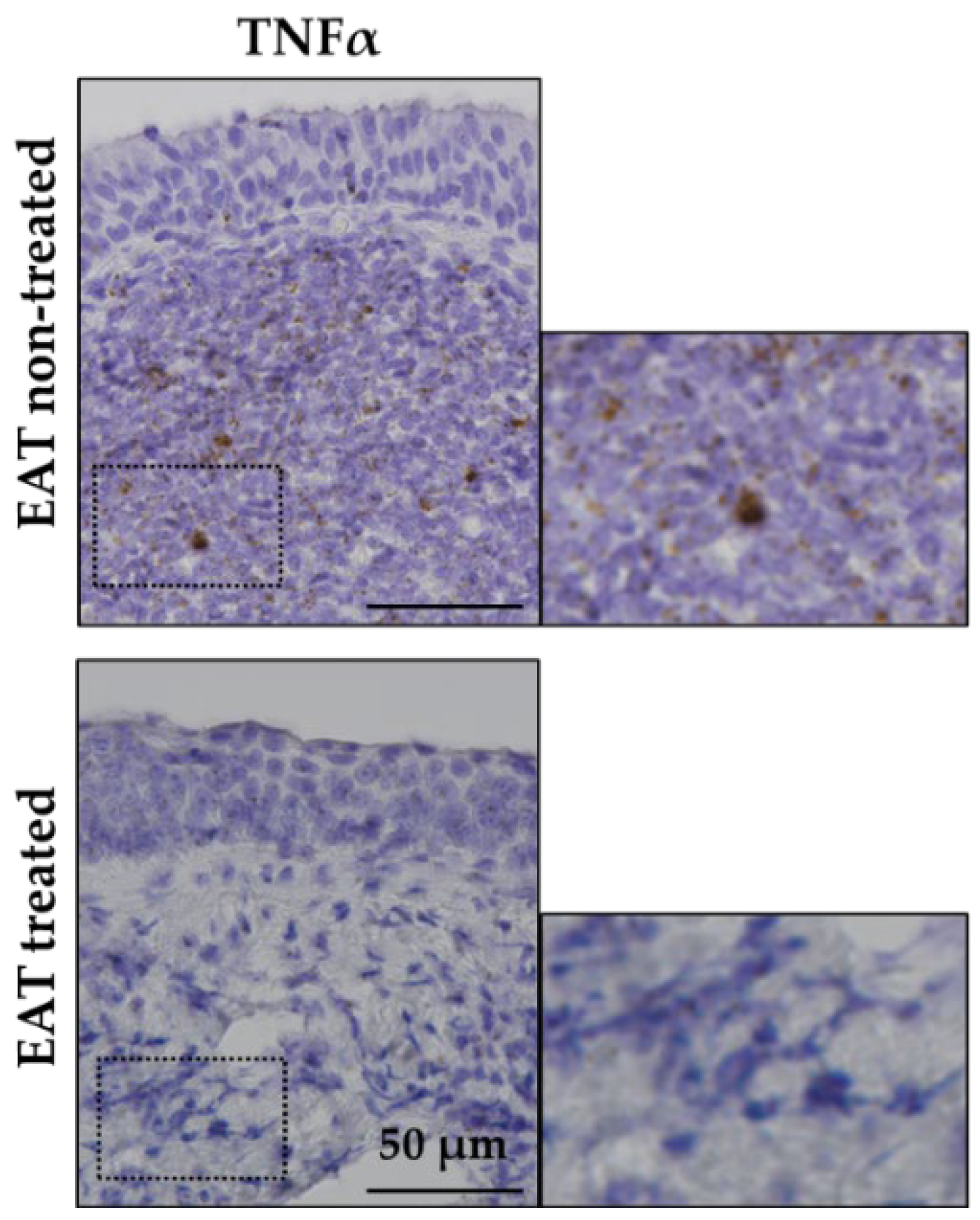Epipharyngeal Abrasive Therapy (EAT) Reduces the mRNA Expression of Major Proinflammatory Cytokine IL-6 in Chronic Epipharyngitis
Abstract
:1. Introduction
2. Results
2.1. Epipharyngeal Abrasive Therapy (EAT) Improved Chronic Epipharyngitis Endoscopically
2.2. B Cells Mainly Secrete Interleukin 6 (IL-6) in the Epipharynx
2.3. Epipharyngeal Abrasive Therapy (EAT) Downregulates the Expression of Interleukin 6 (IL-6)
2.4. Epipharyngeal Abrasive Therapy (EAT) Downregulates the Expression of Tumor Necrosis Factor Alpha (TNFα)
3. Discussion
4. Materials and Methods
4.1. Patients and Tissue Samples
4.2. Epipharyngeal Abrasive Therapy (EAT)
4.3. Antibody
4.4. RNA in Situ Hybridization (ISH) and Immunohistochemical (IHC) Staining
4.5. Statistical Analysis
5. Conclusions
Author Contributions
Funding
Institutional Review Board Statement
Informed Consent Statement
Data Availability Statement
Conflicts of Interest
References
- Hotta, O.; Inoue, C.; Tanaka, A.; Ieiri, N. Possible Mechanisms Underlying Epipharyngeal Abrasive Therapy (EAT) with ZnCl2 Solution for the Treatment of Autoimmune Diseases and Functional Somatic Syndrome. J. Antivir. Antiretrovir. 2017, 9, 81–86. [Google Scholar] [CrossRef]
- Nishi, K.; Nishi, R.; Kimura, S.; Nishi, S.; Tanaka, H.; Yamano, T. Therapeutic effect of epipharyngeal abrasive therapy (EAT) on pharyngeal allergies. Stomato-Pharyngology 2022, 35, 372–374. [Google Scholar]
- Nishi, K.; Yoshimoto, S.; Nishi, S.; Tsunoda, T.; Ohno, J.; Yoshimura, M.; Hiromatsu, K.; Yamano, T. Epipharyngeal Abrasive Therapy Down-regulates the Expression of SARS-CoV-2 Entry Factors ACE2 and TMPRSS2. In Vivo 2022, 36, 371–374. [Google Scholar] [CrossRef] [PubMed]
- Franchi, A.; Palomba, A.; El-Mofty, S.K. Nasopharynx and Oropharynx. In Pathology of the Head and Neck; Cardesa, A., Slootweg, P.J., Gale, N., Franchi, A., Eds.; Springer: Berlin/Heidelberg, Germany, 2016; pp. 295–331. [Google Scholar]
- Imai, K.; Yamano, T.; Nishi, S.; Nishi, R.; Nishi, T.; Tanaka, H.; Tsunoda, T.; Yoshimoto, S.; Tanaka, A.; Hiromatsu, K.; et al. Epipharyngeal Abrasive Therapy (EAT) Has Potential as a Novel Method for Long COVID Treatment. Viruses 2022, 14, 907. [Google Scholar] [CrossRef] [PubMed]
- Mogitate, M.; Sasaki, Y.; Komiyama, A. Outcome of an outpatient specialty clinic for chronic epipharyngitis. Auris Nasus Larynx 2021, 48, 451–456. [Google Scholar] [CrossRef] [PubMed]
- Hotta, O.; Tanaka, A.; Oda, T. Chronic epipharyngitis: A missing background of IgA nephropathy. Autoimmun. Rev. 2019, 18, 835–836. [Google Scholar] [CrossRef] [PubMed]
- Hotta, O.; Ieiri, N.; Inoue, C.; Tanaka, A. Chronic epipharyngitis: A missing trigger in chronic fatigue syndrome. J. Transl. Sci. 2018, 4, 2–3. [Google Scholar] [CrossRef]
- Hotta, O.; Oda, T. The epipharynx-kidney axis triggers glomerular vasculitis in immunoglobulin A nephropathy. Immunol. Res. 2019, 67, 304–309. [Google Scholar] [CrossRef]
- Mogitate, M. Epipharyngeal Abrasive Therapy for Patients with Immunoglobulin A Nephropathy: A Retrospective Study. Sch. J. Otolaryngol. 2022, 8, 874–881. [Google Scholar]
- Fujimoto, M.; Katayama, K.; Nishikawa, K.; Mizoguchi, S.; Oda, K.; Hirabayashi, Y.; Suzuki, Y.; Haruki, A.; Ito, T.; Murata, T.; et al. A Kidney Transplant Recipient with Recurrent Henoch-Schönlein Purpura Nephritis Successfully Treated with Steroid Pulse Therapy and Epipharyngeal Abrasive Therapy. Nephron 2020, 144 (Suppl. 1), 54–58. [Google Scholar] [CrossRef]
- Gabay, C. Interleukin-6 and chronic inflammation. Arthritis Res. Ther. 2006, 8, S3. [Google Scholar] [CrossRef] [PubMed]
- Rossi, J.F.; Lu, Z.Y.; Jourdan, M.; Klein, B. Interleukin-6 as a therapeutic target. Clin. Cancer Res. Off. J. Am. Assoc. Cancer Res. 2015, 21, 1248–1257. [Google Scholar] [CrossRef] [PubMed]
- Cortes Rivera, M.; Mastronardi, C.; Silva-Aldana, C.T.; Arcos-Burgos, M.; Lidbury, B.A. Myalgic Encephalomyelitis/Chronic Fatigue Syndrome: A Comprehensive Review. Diagnostics 2019, 9, 91. [Google Scholar] [CrossRef] [PubMed]
- Raanes, E.F.W.; Stiles, T.C. Associations Between Psychological and Immunological Variables in Chronic Fatigue Syndrome/Myalgic Encephalomyelitis: A Systematic Review. Front. Psychiatry 2021, 12, 716320. [Google Scholar] [CrossRef]
- Shi, Y.; Pestka, J.J. Attenuation of mycotoxin-induced IgA nephropathy by eicosapentaenoic acid in the mouse: Dose response and relation to IL-6 expression. J. Nutr. Biochem. 2006, 17, 697–706. [Google Scholar] [CrossRef]
- Groza, Y.; Jemelkova, J.; Kafkova, L.R.; Maly, P.; Raska, M. IL-6 and its role in IgA nephropathy development. Cytokine Growth Factor Rev. 2022, 66, 1–14. [Google Scholar] [CrossRef]
- Kappelmann, N.; Dantzer, R.; Khandaker, G.M. Interleukin-6 as potential mediator of long-term neuropsychiatric symptoms of COVID-19. Psychoneuroendocrinology 2021, 131, 105295. [Google Scholar] [CrossRef]
- Hotta, O.; Ieiri, N.; Nagai, M.; Tanaka, A.; Harabuchi, Y. Role of Palatine Tonsil and Epipharyngeal Lymphoid Tissue in the Development of Glomerular Active Lesions (Glomerular vasculitis) in Immunoglobulin A Nephropathy. Int. J. Mol. Sci. 2022, 23, 727. [Google Scholar] [CrossRef]
- Bourges, D.; Wang, C.H.; Chevaleyre, C.; Salmon, H. T and IgA B lymphocytes of the pharyngeal and palatine tonsils: Differential expression of adhesion molecules and chemokines. Scand J. Immunol. 2004, 60, 338–350. [Google Scholar] [CrossRef]
- Shin, I.; Hotta, O.; Tani, S. Epipharyngeal abrasive therapy in myalgic encephalomyelitis/chronic fatigue syndrome patients. Jpn. J. Clin. Med. 2021, 79, 989–994. [Google Scholar]
- Tanaka, A.; Hotta, O. The efficacy of Intranasal Sphenopalatine Ganglion Stimulation (INSPGS) in Long COVID, and its Possible Mechanisms. Sch. J. Otolaryngol. 2022, 8, 860–864. [Google Scholar]
- Harabuchi, Y.; Takahara, M. Recent advances in the immunological understanding of association between tonsil and immunoglobulin A nephropathy as a tonsil-induced autoimmune/inflammatory syndrome. Immun. Inflamm. Dis. 2019, 7, 86–93. [Google Scholar] [CrossRef] [PubMed]
- Tanaka, A. Specifics of each method of endoscopic transnasal epipharyngeal abrasive therapy (E-TN-EAT) and endoscopic transoral epipharyngeal abrasive therapy (E-TO-EAT). Stomato-Pharyngology 2020, 33, 5–16. [Google Scholar]
- Narazaki, M.; Kishimoto, T. The Two-Faced Cytokine IL-6 in Host Defense and Diseases. Int. J. Mol. Sci. 2018, 19, 3528. [Google Scholar] [CrossRef] [PubMed]
- Hirano, T. IL-6 in inflammation, autoimmunity and cancer. Int. Immunol. 2020, 33, 127–148. [Google Scholar] [CrossRef]
- Kishimoto, T. IL-6: From its discovery to clinical applications. Int. Immunol. 2010, 22, 347–352. [Google Scholar] [CrossRef]
- Yao, X.; Huang, J.; Zhong, H.; Shen, N.; Faggioni, R.; Fung, M.; Yao, Y. Targeting interleukin-6 in inflammatory autoimmune diseases and cancers. Pharmacol. Ther. 2014, 141, 125–139. [Google Scholar] [CrossRef]
- Wang, A.; Fogel, A.L.; Murphy, M.J.; Panse, G.; McGeary, M.K.; McNiff, J.M.; Bosenberg, M.; Vesely, M.D.; Cohen, J.M.; Ko, C.J.; et al. Cytokine RNA In Situ Hybridization Permits Individualized Molecular Phenotyping in Biopsies of Psoriasis and Atopic Dermatitis. JID Innov. 2021, 1, 100021. [Google Scholar] [CrossRef]
- Arkatkar, T.; Du, S.W.; Jacobs, H.M.; Dam, E.M.; Hou, B.; Buckner, J.H.; Rawlings, D.J.; Jackson, S.W. B cell–derived IL-6 initiates spontaneous germinal center formation during systemic autoimmunity. J. Exp. Med. 2017, 214, 3207–3217. [Google Scholar] [CrossRef]
- Ramsay, A.J.; Husband, A.J.; Ramshaw, I.A.; Bao, S.; Matthaei, K.I.; Koehler, G.; Kopf, M. The role of interleukin-6 in mucosal IgA antibody responses in vivo. Science 1994, 264, 561–563. [Google Scholar] [CrossRef]
- Schultheiß, C.; Willscher, E.; Paschold, L.; Gottschick, C.; Klee, B.; Henkes, S.S.; Bosurgi, L.; Dutzmann, J.; Sedding, D.; Frese, T.; et al. The IL-1β, IL-6, and TNF cytokine triad is associated with post-acute sequelae of COVID-19. Cell Rep. Med. 2022, 3, 100663. [Google Scholar] [CrossRef] [PubMed]
- Dantzer, R.; O’Connor, J.C.; Freund, G.G.; Johnson, R.W.; Kelley, K.W. From inflammation to sickness and depression: When the immune system subjugates the brain. Nat. Rev. Neurosci. 2008, 9, 46–56. [Google Scholar] [CrossRef] [PubMed]
- Leger-Ravet, M.B.; Peuchmaur, M.; Devergne, O.; Audouin, J.; Raphael, M.; Van Damme, J.; Galanaud, P.; Diebold, J.; Emilie, D. Interleukin-6 Gene Expression in Castleman’s Disease. Blood 1991, 78, 2923–2930. [Google Scholar] [CrossRef] [PubMed]
- Wei, Y.F.; Yin, P.; Liu, L.; Wu, S.S.; Jia, L.; Sun, S. Effects of APELIN-13 on the expression of IL-6, TNF-α, and IFN-γ in rats with experimental autoimmune neuritis. J. Biol. Regul. Homeost Agents 2019, 33, 1369–1376. [Google Scholar] [PubMed]
- Meng, Y.; Wang, C.; Zhang, L. Recent developments and highlights in allergic rhinitis. Allergy 2019, 74, 2320–2328. [Google Scholar] [CrossRef] [PubMed]
- Ciprandi, G.; Silvestri, M.; Pistorio, A.; Tosca, M.A.; Cirillo, I. Clustering analysis in outpatients with allergic rhinitis in clinical practice. Allergy 2019, 74, 607–610. [Google Scholar] [CrossRef]
- Gao, S.; Yu, L.; Zhang, J.; Li, X.; Zhou, J.; Zeng, P.; Zhang, X. Expression and clinical significance of VCAM-1, IL-6, and IL-17A in patients with allergic rhinitis. Ann. Palliat. Med. 2021, 10, 4516–4522. [Google Scholar] [CrossRef]
- Horiuchi, T.; Mitoma, H.; Harashima, S.-i.; Tsukamoto, H.; Shimoda, T. Transmembrane TNF-α: Structure, function and interaction with anti-TNF agents. Rheumatology 2010, 49, 1215–1228. [Google Scholar] [CrossRef]
- Ratliff, M.; Alter, S.; Frasca, D.; Blomberg, B.B.; Riley, R.L. In senescence, age-associated B cells secrete TNFα and inhibit survival of B-cell precursors. Aging Cell 2013, 12, 303–311. [Google Scholar] [CrossRef]
- Jang, D.-I.; Lee, A.-H.; Shin, H.-Y.; Song, H.-R.; Park, J.-H.; Kang, T.-B.; Lee, S.-R.; Yang, S.-H. The Role of Tumor Necrosis Factor Alpha (TNF-α) in Autoimmune Disease and Current TNF-α Inhibitors in Therapeutics. Int. J. Mol. Sci. 2021, 22, 2719. [Google Scholar] [CrossRef]
- Dey, M.; Zhao, S.S.; Moots, R.J. Anti-TNF biosimilars in rheumatology: The end of an era? Expert Opin. Biol. 2021, 21, 29–36. [Google Scholar] [CrossRef] [PubMed]
- Mazumdar, S.; Greenwald, D. Golimumab. mAbs 2009, 1, 422–431. [Google Scholar] [CrossRef] [PubMed]
- Melsheimer, R.; Geldhof, A.; Apaolaza, I.; Schaible, T. Remicade(®) (infliximab): 20 years of contributions to science and medicine. Biologics 2019, 13, 139–178. [Google Scholar] [PubMed]
- Chima, M.; Lebwohl, M. TNF inhibitors for psoriasis. Semin. Cutan. Med. Surg. 2018, 37, 134–142. [Google Scholar] [CrossRef]
- Hotta, O. Chronic epipharyngitis and its possible focal-infection role. Stomato-Pharyngology 2010, 23, 37–42. [Google Scholar]





| IL-6 Positive | IL-6 Negative | Chi-Square Value | |
|---|---|---|---|
| EAT nontreated | 8 | 0 | 0.0015 |
| EAT-treated | 3 | 8 |
Publisher’s Note: MDPI stays neutral with regard to jurisdictional claims in published maps and institutional affiliations. |
© 2022 by the authors. Licensee MDPI, Basel, Switzerland. This article is an open access article distributed under the terms and conditions of the Creative Commons Attribution (CC BY) license (https://creativecommons.org/licenses/by/4.0/).
Share and Cite
Nishi, K.; Yoshimoto, S.; Nishi, S.; Nishi, T.; Nishi, R.; Tanaka, T.; Tsunoda, T.; Imai, K.; Tanaka, H.; Hotta, O.; et al. Epipharyngeal Abrasive Therapy (EAT) Reduces the mRNA Expression of Major Proinflammatory Cytokine IL-6 in Chronic Epipharyngitis. Int. J. Mol. Sci. 2022, 23, 9205. https://doi.org/10.3390/ijms23169205
Nishi K, Yoshimoto S, Nishi S, Nishi T, Nishi R, Tanaka T, Tsunoda T, Imai K, Tanaka H, Hotta O, et al. Epipharyngeal Abrasive Therapy (EAT) Reduces the mRNA Expression of Major Proinflammatory Cytokine IL-6 in Chronic Epipharyngitis. International Journal of Molecular Sciences. 2022; 23(16):9205. https://doi.org/10.3390/ijms23169205
Chicago/Turabian StyleNishi, Kensuke, Shohei Yoshimoto, Soichiro Nishi, Tatsuro Nishi, Ryushiro Nishi, Takayuki Tanaka, Toshiyuki Tsunoda, Kazuaki Imai, Hiroaki Tanaka, Osamu Hotta, and et al. 2022. "Epipharyngeal Abrasive Therapy (EAT) Reduces the mRNA Expression of Major Proinflammatory Cytokine IL-6 in Chronic Epipharyngitis" International Journal of Molecular Sciences 23, no. 16: 9205. https://doi.org/10.3390/ijms23169205
APA StyleNishi, K., Yoshimoto, S., Nishi, S., Nishi, T., Nishi, R., Tanaka, T., Tsunoda, T., Imai, K., Tanaka, H., Hotta, O., Tanaka, A., Hiromatsu, K., Shirasawa, S., Nakagawa, T., & Yamano, T. (2022). Epipharyngeal Abrasive Therapy (EAT) Reduces the mRNA Expression of Major Proinflammatory Cytokine IL-6 in Chronic Epipharyngitis. International Journal of Molecular Sciences, 23(16), 9205. https://doi.org/10.3390/ijms23169205






